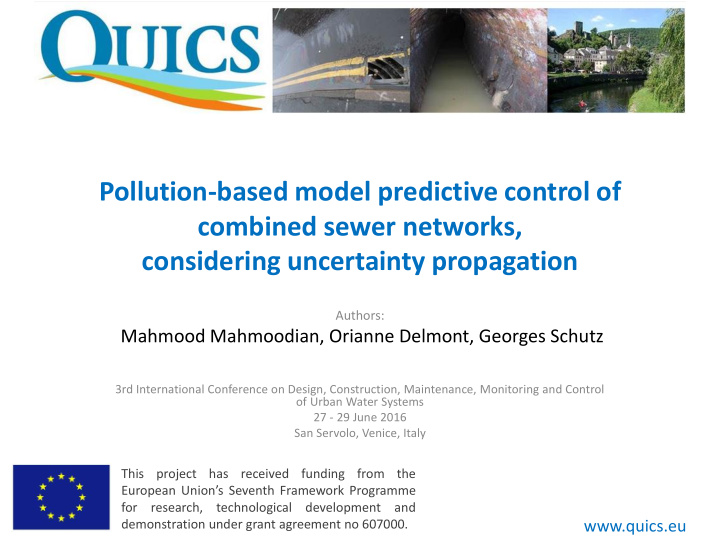



Pollution-based model predictive control of combined sewer networks, considering uncertainty propagation Authors: Mahmood Mahmoodian, Orianne Delmont, Georges Schutz 3rd International Conference on Design, Construction, Maintenance, Monitoring and Control of Urban Water Systems 27 - 29 June 2016 San Servolo, Venice, Italy This project has received funding from the European Union’s Seventh Framework Programme for research, technological development and demonstration under grant agreement no 607000. www.quics.eu
Outline: Introduction Case Study Methodology Results and Discussion Conslusions
Introduction Combined Sewer Network Wet weather flow (WWF) Dry weather flow (DWF) Pollution Risk Source: http://whenitrains.commons.gc.cuny.edu/ Wastewater quantity and quality Real-time control (RTC) Fast (simple) model Uncertainty analysis No modification on the physical network
Case Study Haute-Sûre catchment, Luxembourg • Location: Northwest of Luxembourg. • Capacity: 12000 population equivalents (PE). Future Plan: 24 Sub-catchments with 24 CSO tanks. • In this research only two of CSO tanks are considered to test the controllers Haute-Sûre catchment (D. Fiorelli, G. Schutz, 2009) Blue: Buderscheid CSO tank Green: Kaundorf CSO tank Measured inflow to the tanks during the October 2002 rain scenario
Methodology: Control model Real-time Control (simulation) (Optimization) CVX solver Quantitative Wastewater Quantity Objective model function Model Predictive Comparison of the Control (MPC) Results Qualitative Wastewater Quality Objective Model function fmincon solver
Method: Wastewater Quantity model The flow in the network: Simple tank model: Modelled using the delay time concept. Based on conservation of volume in the tank. measured System variables Time delay concept used in the network modelling. h: wastewater level in the tank (measured by sensor) V: wastewater volume in the tank Qin: inflow Qout: outflow (measured and subject to control) Vov: overflow volume C: concentration of the pollutant load in the tank
Method: Wastewater Quality model Three main assumptions, there is: 1. Only one global indicator to reflect the pollution load; 2. Only a simple dilution effect in the tank; Homogeneous concentration of the pollutant load 3. in the tank ‘C’ Taking into account previous equations and mass balance law: System variables
Method: Optimization Quantitative Objective Function
Method: Optimization Qualitative Objective Function Objectives: Φ 4 : to minimize the overflowed mass. Φ 5 : to minimize the uncertainty present in the concentration of the mass which is directly linked to the above mentioned goal Φ 4 . Φ 6 : to distribute the pollutant mass over the network homogenously which is in fact similar to Φ 1 . Φ 7 : to maximize the pollutant mass arriving at the WWTP Constraints The volume of wastewater in each tank, the outflow, and the wastewater contained in the pipes are all positive variables and limited by their maximum capacity
Method: Uncertainty propagation Taylor series of first order approximation • Reasons: 1. because the qualitative model, although not linear, is differentiable. 2. Besides, through measures in the real system for each variable in our simple model there is an idea about the tolerance interval in which it is located. With: 𝐵 1 = C( 𝑢 - 𝛦𝑢 ), 𝐵 2 = V( 𝑢 - 𝛦𝑢 ), 𝐵 3 = 𝑅 𝑗𝑜 ( 𝑢 ), 𝐵 4 = 𝐷 𝑗𝑜 ( 𝑢 - 𝛦𝑢 ), 𝐵 5 = 𝑅 𝑝𝑣𝑢 ( 𝑢 ), 𝐵 6 = 𝑊 𝑝𝑤 ( 𝑢 - 𝛦𝑢 ).
Model Predictive Control (MPC) An advanced real-time control (RTC) approach which employs an internal model in order to forecast the behaviour of the given system in future over a finite time horizon (receding horizon). The principle of receding horizon in shown here:
Results and Discussion A) Comparison of the controllers quantitatively: Volume in the tanks (m3) Overflow volume (m3) blue: Buderscheid CSO tank; green: Kaundorf CSO tank Former controller: Quantitative New controller: Qualitative Overflow volume (Green): 52.8 m 3 Overflow volume (Green): 45.9 m 3 Overflow volume (Blue): 4.5 m 3 Overflow volume (Blue): 3.5 m 3 Total overflow volume: 57.3 m 3 Total overflow volume: 49.4 m 3 13.8%
Results and Discussion B) Comparison of the controllers qualitatively: Overflowed mass (kg) blue: Buderscheid CSO tank; green: Kaundorf CSO tank Former controller: Quantitative New controller: Qualitative Overflowed mass (Green): 27 kg Overflowed mass (Green): 23.5 kg Overflowed mass (Blue): 2.3 kg Overflowed mass (Blue): 1.8 kg Total overflowed mass: 29.3 kg Total overflowed mass: 25.3 kg The difference 13.6% goes to the WWTP
Conclusions The main idea was to understand if the quality-based controller can improve the performance of the quantity-based controller. the results showed a positive contribution of the quality-based controller in decreasing the overflowed pollution mass as well as CSO volume during the selected rain scenario. the new controller reduces the pollution load and overflow volume without the need to add new physical elements (e.g. sensors) to the system which are normally expensive to purchase and maintain. In fact, this is a very promising result and can be considered as a ‘soft’ solution for combined sewer network management.
Thank you for your attention Any questions?
Partners and Acknowledgements This project has received funding from the European Union’s Seventh Framework Programme for research, technological development and demonstration under grant agreement no 607000. www.quics.eu
Recommend
More recommend